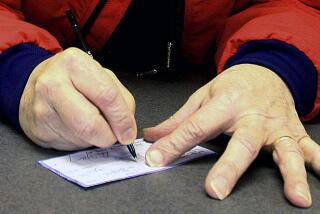Paying a Bill May Be the Easy Part
- Share via
There are many everyday occurrences with legal repercussions. One of them is making payment. With holiday bills arriving, it seems appropriate to review steps you can take to protect yourself from disputes that may arise from the payment of bills or other money owed.
Let’s start with a common way of making payment--cash. You purchase groceries, for example, and get a receipt for the amount paid. Ordinarily there is no need to do more. However, you might not always receive a receipt when paying rent or other large amounts, in which case you should demand one, and keep it. Make sure the receipt indicates the rental period covered or the specific product purchased.
If you pay by credit card, keep a copy of the charge slip. The monthly statement will list the charges, and mistakes can happen. Compare the monthly statement to your receipts. If you find an unfamiliar charge, call the credit card company to find out about the questionable item. Is it a charge you authorized by telephone? Is the company’s legal name listed different than its retail name? If you think there is an error, complain in writing in a timely manner. Check your rights, listed on the back of the credit card bill.
When paying by check, write enough on the check to identify the purpose of the payment. For example, if making a monthly rental payment, note the period covered. Or, if paying an insurance installment, indicate the policy number and any other information that might help the company credit your payment.
Payment of the amount due on a negotiable note involves another step. It isn’t enough to make the payment, even if the check notes the purpose of the payment. Nor is a receipt sufficient for cash payment of a note. The note should be returned to you when paid in full. Write paid in full or this note is canceled on the note, and keep it for, say, four years.
Often, though, you will be paying on an installment note. Make sure that the payment is made to the right person or company. Sometimes that will differ from the “payee” named on the note. The note may have been “negotiated” (transferred) to a new “holder” or owner. The installment note may have a payment schedule attached. Try to ensure that each installment is recorded on schedule. If the note covers a long period, occasionally verify the balance due.
One of the trickiest payments is the final one on a note secured by a deed of trust or mortgage. You purchased your home or other real estate years ago and now the moment has arrived when you pay the final balance. But it is not enough to get the note back. When you signed that note years ago, you also signed a Deed of Trust, which was recorded. That Deed of Trust is a “lien” on the property.
If you try to sell the property the lien will show up on the title report unless you had the deed of trust “reconveyed.”
When you pay in full, get the note returned to you and have the owner of the note sign a “Request for Full Reconveyance.” Have the reconveyance recorded by delivering the documents to the Trustee named in the Deed of Trust with instructions to record. There may be a small charge. Pay it. If you don’t do so, you will cause yourself or your heirs delay and expense (sometimes considerable expense and perhaps even a lawsuit) in clarifying title to the property.
More to Read
Inside the business of entertainment
The Wide Shot brings you news, analysis and insights on everything from streaming wars to production — and what it all means for the future.
You may occasionally receive promotional content from the Los Angeles Times.










